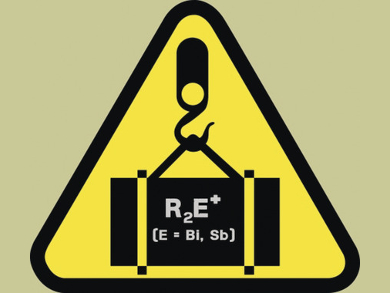Carbenes (R2C) and carbocations (R3C+), as well as their heavier group 14 analogues, are usually highly reactive species. Jens Beckmann, University of Bremen, Germany, Stefan Mebs, Free University of Berlin, Germany, and colleagues have prepared the first group 15 carbene analogues, namely, bismuthenium and stibenium ions R2E+ (E = Bi,Sb). These compounds combine the synthetic challenges of the aforementioned compound classes, namely, a positive charge, a lone pair of electrons, and electron deficiency.
The kinetic stabilization of the R2E+ ions was achieved by hydride and chloride abstraction from appropriate precursors, R2EX (X = H,Cl), using bulky m-terphenyl substituents R, and weakly coordinating anions, namely, fluorinated borate [BArF4]– ions.
The new species were fully characterized and their electronic structure was investigated using density functional theory (DFT) calculations. The bismuthenium and stibenium ions are expected to show an interesting ambivalent reactivity, as they could simultaneously act as Lewis acids and Lewis bases. In addition, the bismuth and antimony atoms might also be redox-active.
- Heavy Carbene Analogues: Donor-Free Bismuthenium and Stibenium Ions,
Marian Olaru, Daniel Duvinage, Enno Lork, Stefan Mebs, Jens Beckmann,
Angew. Chem. Int. Ed. 2018.
https://doi.org/10.1002/anie.201803160




